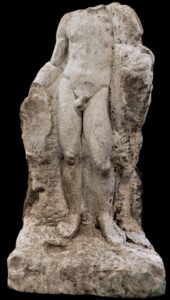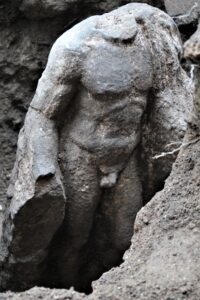 A rare unfinished statue from the Roman Imperial era has been unearthed in Veria in Central Macedonia, Greece. It was discovered last Friday in a rescue excavation of one of very few sites in this ancient city that has not been built on before.
A rare unfinished statue from the Roman Imperial era has been unearthed in Veria in Central Macedonia, Greece. It was discovered last Friday in a rescue excavation of one of very few sites in this ancient city that has not been built on before.
The ancient city of Veria was an important political and military center under the Macedonian kings of the Argead Dynasty, most famously Alexander the Great and his father Philip II. It was second only to the Argead capital of Pella in importance, and after the death of Alexander’s son put an end to the Argead rule, Veria became the seat of the Macedonian Koinon (commonwealth). After the Roman conquest, the koinon was reshaped into a civic institution with a focus on the imperial cult run by local elites. Veria flourished under Rome, eclipsing Pella to become the main regional center. When Diocletian restructured the administration of the empire in 293 A.D., Veria became one of two capitals of the new Roman province of Macedonia. (The other was Thessaloniki.)
 The statue’s style suggests it was carved when the city was prospering in the late 2nd or early 3rd century A.D. Just over three feet tall, the statue is missing its head and is still encased in some of the marble block from which it was carved. The nude youth wears a chlamys (cloak) draped around his left shoulder. As it is unfinished and headless, narrowing down the subject is impossible, but Statues of naked men were either athletes or gods in the Greek sculptural tradition, but the subject is unknown here due to its unfinished, headless condition. Hermes, one of the Dioscuri (the twins Castor and Pollux) and Apollo are all possibilities, as is Alexander the Great.
The statue’s style suggests it was carved when the city was prospering in the late 2nd or early 3rd century A.D. Just over three feet tall, the statue is missing its head and is still encased in some of the marble block from which it was carved. The nude youth wears a chlamys (cloak) draped around his left shoulder. As it is unfinished and headless, narrowing down the subject is impossible, but Statues of naked men were either athletes or gods in the Greek sculptural tradition, but the subject is unknown here due to its unfinished, headless condition. Hermes, one of the Dioscuri (the twins Castor and Pollux) and Apollo are all possibilities, as is Alexander the Great.
It is the work of a very skilled craftsman who, for whatever reason, never finished the piece. The sculptor, although he had advanced far in the creation of his sculpture, had reached a point almost at the final stage when he apparently decided to abandon the effort, unfinished.
This fact makes the discovery of the statue even more significant, however, since it gives art historians an opportunity to study not only the style, but the production techniques of these types of artworks.
The statue may have been meant as an exact copy or a freer recreation of a famous original; either way, it can help researchers understand the Veroia school of sculpture from a completely different point of view.
Working front to back, just as Vasari describes Michelangelo’s technique: “The method is to take a figure of wax, lay it in a vessel of water and gradually emerge it, and then note the most salient parts. Just so, the highest parts were extracted first from the marble.”